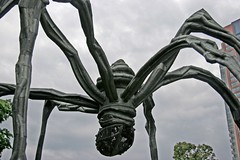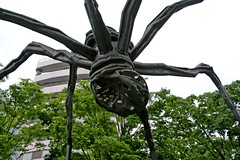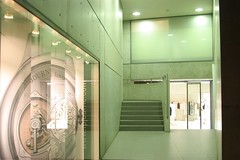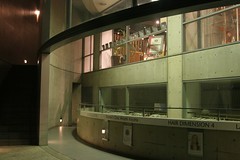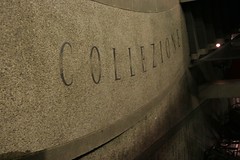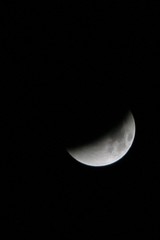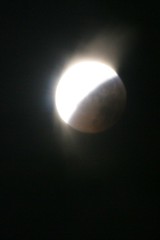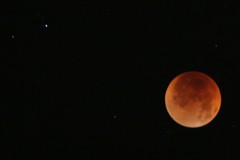
As 2007 drew to a close, I ordered the Canon EF 24-70mm f/2.8L USM lens, to fill in the gap of f/2.8L lenses in my collection. Two years ago, I had purchased the Canon EF 24-105mm f/4L USM IS lens as a general walkabout lens for my Canon EOS 20D. Since then, I have purchased a Canon EOS 5D and use the 20D mostly as a secondary body. I've also purchased a Canon PowerShot SD800 IS to do most of my photography that doesn't involve a DSLR.
Designwise, the 24-70 is the mechanical inverse of the 24-105. While both feature a telescoping design, on the 24-70, the widest angle is when the tube is fully extended, and on the 24-105, the widest angle is when the tube is fully retracted. The location of the lens hood is different also, where the 24-105 is attached to the telescoping front element, and the 24-70 lens hood is attached at a stationary mount point unattached to the front element.
The 24-105 acts as a great introduction to Canon's professional L series of lenses. It is a general purpose lens, and it covers the range of 24mm to 105mm. It includes image stabilization, which helps in situations where you want to avoid camera shake and use a slower shutter speed. My one problem with this lens is that at f/4, this lens isn't fast. The image stabilization is especially useful at focal ranges upwards of 70mm.
When I first attached the 24-70 to my 5D and looked through the viewfinder, my first reaction was "Shouldn't this thing go further?" The 24-105 has spoiled me in this respect, giving me an additional 35mm of zoom. While it doesn't seem like a lot, it is an additional 43% of range over the 24-70.
Both the 24-105 and the 24-70 have always been close in terms of price, with a $100 price difference between the two. The 24-70 f/2.8L has a larger aperture, while the 24-105 f/4L features image stabilization and 35mm more range.
I tested these two lenses against each other in a series of tests, pitting aperture size against image stabilization, as well as seeing if there was any visible difference between the two lenses at an aperture size of f/4.
In photography, the general guideline is that one should try and shoot at a shutter speed no greater than the inverse of the focal length of the lens. This means that using a 50mm lens, the shutter speed to use is no more than 1/50, because at speeds slower than that, one can introduce camera shake to the photograph. Image stabilization on the 24-105 helps this by attempting to remove camera shake by using a lens which corrects for this -- effectively adding 3 stops to the camera, meaning that at 105mm, one could effectively handhold a shot up to a shutter speed of 1/15. Shooting at such a low shutter speed introduces the problem of motion blur, which image stabilization cannot correct for.
In my tests, I was shooting in a natural light lit room, at ISO 400 and f/4 aperture size. The difference between the two lenses are negligible at f/4. The photos below feature one being taken with 24-70, and the other being taken by the 24-105 at a 24mm:

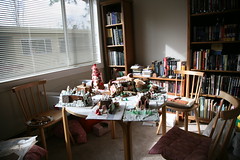
The picture that features the slightly wider perspective is the 24-105. Because both pictures were shot from the same spot, and because the 24-70 is slightly longer than the 24-105, the difference due to the difference in length from the two lenses.
My small subcompact Canon PowerShot SD800 IS features a focal length of 28-105mm, so I shot the following picture:

At web resolutions, the shot looks brighter than the other two shots, and just as crisp and focused, but while the DSLR shots were taken at ISO 400 with a aperture size of f/4 and a shutter speed of 1/640, the SD800 took the shot at at ISO 400 with an aperture of f/2.8 and a shutter speed of 1/60. A closer look at the file reveals the SD800 contains much more noise than either of the DSLR shots.
In the end, the question of which lens to buy comes down to the user and their purpose. For someone who wants a lens that they can use all day long, the 24-105 f/4L is a well-rounded versatile lens. It has its shortcomings in low light conditions, but the extra length and the image stabilization at the longer end make up for that. I have gone on trips where the the 24-105 was my main lens.
The 24-70, while heavier and featuring a shorter range, also features a much larger aperture, making it a faster lens. On a 1.6x crop factor camera, the 24-70 is a good length, but on a full-frame camera like the 5D, it feels rather short. This is likely why Canon chose to bundle the Canon EF 24-105 f/4L USM lens with the EOS 5D Both are really good lenses, and after this series of tests, I can really no longer recommend one over the other, as they are both good for different reasons.





